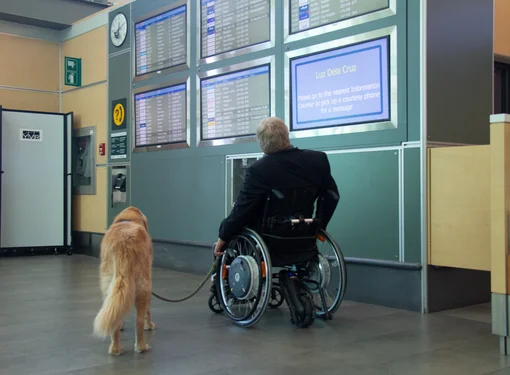Inclusive workplaces: It's more than just getting in the door
Barriers in the built environment like stairs, manual doors, or narrow doorways are all common obstacles that stop people with disabilities, or aging seniors, from accessing workplaces. But it’s not just a matter of accessibility. People with mobility, hearing and vision disabilities face other barriers to employment as well.
According to Statistics Canada, only 49% of people with disabilities between the ages of 25 and 64 are employed (compared to 79% without a disability). Graduates with a disability are less likely to hold a management position and they earn less than those without a disability, especially men.
These stats can be misinterpreted. One pervasive myth is that people with disabilities aren’t employed because they’re unable or unwilling to work. In fact, people with disabilities are talented, educated, and motivated to succeed. Job sites like WorkBC have an archive of success stories showing people with disabilities enjoying a wide range of careers.
So how we think about disability and employment needs to change. A national network of business leaders, including Tim Horton’s, Loblaw, and IBM, belong to Canadian Business SenseAbility, which provides resources to transform businesses into fully inclusive workplaces. The Conference Board of Canada has developed a toolkit for employers on accessibility and inclusion. And many disability organizations across Canada have created lists busting myths about disabilities.
We can start making our workplaces more inclusive by challenging the lingering misconceptions preventing capable people from finding meaningful employment and living to their full potential.
What keeps workplaces from being fully inclusive?
The decision to not hire people with disabilities is often based in a culture of uncertainty and fear.
Employers may assume the job won’t get done effectively or efficiently, or that accommodating people with disabilities is too expensive and time consuming. People without a disability or with very little exposure to disability may be afraid they’ll say or do the wrong things when working with someone who has different needs and requirements.
A lack of awareness or understanding of the many types of disability can create the notion that disability equals special treatment. This only reinforces the existing culture, allowing for discrimination.
A common myth of hiring people with disabilities is, employer concerns may range from poor performance standards and persistent absenteeism to violating human rights law. All of this is false. When businesses and organizations provide for all their employees’ individual needs, the workplace naturally reflects best practices. If all employees have an equal opportunity to thrive, it adds value to any organization. Everyone, including customers and stakeholders, feels the benefits.
Inclusion just makes good business sense. Provincial legislation combined with the growing national demand for accessibility is actively removing physical barriers in our public buildings and spaces. Advancements in assistive technology has broken down many communications barriers. As the number of people with a disability in Canada expected to rise to one in five by 2036, it’s not good sense to ignore the economic and social costs of a growing segment of the population.
What can I do to make my workplace more inclusive?
Here are a few ideas for both employers and employees on how to make workplaces more inclusive:
If you’re an employer, you can:
- Develop a business case promoting the benefits of inclusion to bring others on board.
- Do a formal accessibility or inclusion assessment and encourage employees to participate.
- Convene a working group to develop management and HR policies, procedures, and plans to remove physical and social barriers.
If you’re an employee, you can:
- Lead by example to influence change in workplace culture.
- Be a myth buster – hold a lunch-and-learn to raise awareness of inclusion and accessibility.
- Follow an accessibility and inclusion checklist and ask coworkers to participate with you to assess your workplace. This can help determine where changes might need to be made.
Employers and employees can:
- Encourage an ongoing dialogue about inclusion and accessibility.
- Use people-first language in all communications to create a positive working environment.
- Participate in a disability awareness or sensitivity training session.
By putting just a few of these suggestions into place, you can help take action to make your workplaces more accessible, inclusive and respectful for all employees of all abilities.
*Here's another great inclusive workplace resource from Marco Pasqua at VanCity: 4 tips for creating more inclusive workplaces




